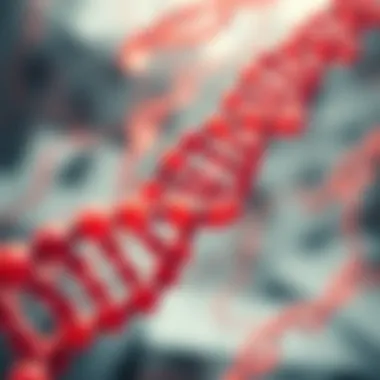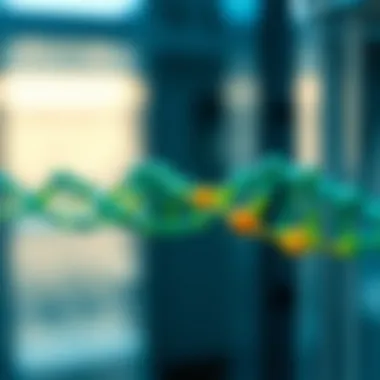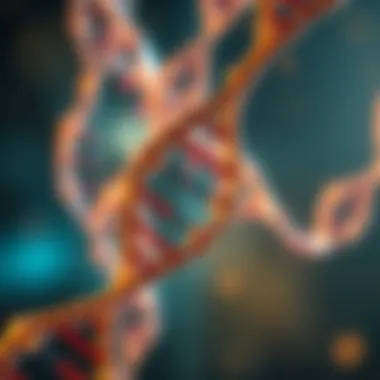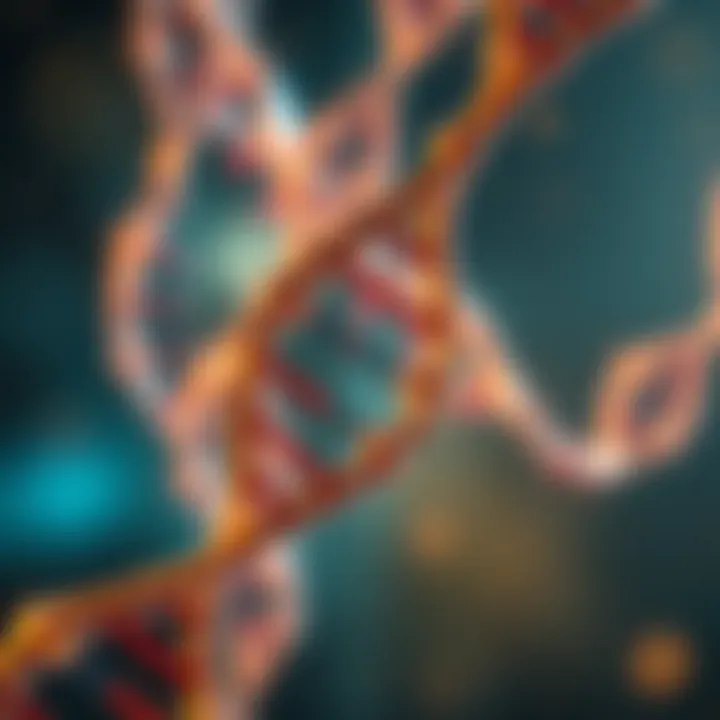Techniques and Applications of DNA Labeling


Intro
DNA labeling stands at the crossroads of biology and technology, shaping how we investigate the molecular underpinnings of life. The process allows for the tagging of DNA molecules so they can be traced and visualized in various experiments. From understanding genetic disorders to innovating new forensic techniques, the applications of DNA labeling are remarkably broad and impactful.
In today's rapidly evolving scientific landscape, it is essential to grasp what DNA labeling entails and how it can push the boundaries of research. This article aims to illuminate the diverse techniques used in DNA labeling, explore their myriad applications across fields such as genomics and forensic science, and discuss the challenges and future prospects that these technologies bring to the table.
Key Concepts
Definition of the Main Idea
DNA labeling is an essential technique where specific DNA molecules are marked or tagged with various agents. This bright spotlight allows scientists and researchers to monitor and analyze these molecules in a range of environments, whether inside living organisms or in controlled laboratory settings. The core objective is simple: make the invisible visible. It serves a crucial role in numerous studies, helping to discern the role of genes, their interactions, and how they behave in different conditions.
Overview of Scientific Principles
Understanding why DNA labeling is necessary starts with a basic grasp of DNA itself. Each DNA molecule is made up of sequences of nucleotides, which are the building blocks that encode genetic information. When it comes to labeling, scientists can use a number of methods such as the incorporation of fluorescent dyes or biotin tags. These labels help in visualizing the DNA within a mixture or within cells, often utilizing microscopes or other imaging techniques.
The implications of successful DNA tagging extend to several critical areas:
- Genomics: Mapping out genomics not only aids in understanding genetic diseases but also aligns with the advancements in personalized medicine.
- Forensics: In forensic science, DNA labeling can aid in the identification of individuals based on genetic information from biological samples.
- Synthetic Biology: The creation of new biological parts, devices, and systems can be substantially enhanced through effective DNA labeling.
"In the quest to unravel genetic mysteries, DNA labeling shines a beacon of light, guiding researchers through the intricate pathways of molecular biology."
"In the quest to unravel genetic mysteries, DNA labeling shines a beacon of light, guiding researchers through the intricate pathways of molecular biology."
By introducing clarity into DNA structures and their interactions, labeling serves as a catalyst for innovation and discovery, thus elevating the science of genetics and its applications to new heights.
Current Research Trends
Recent Studies and Findings
Current literature reveals that cutting-edge research is making great strides in DNA labeling methodologies. For instance, new fluorescent protein technologies have emerged, allowing for more precise and long-term tracking of DNA activities in real time.
Research published in prestigious journals highlights the use of CRISPR-based methods for efficient labeling in living organisms, enabling visual mapping of gene functions with unprecedented accuracy. Moreover, innovations such as super-resolution microscopy are pushing the boundaries of what can be observed at the molecular level.
Significant Breakthroughs in the Field
Noteworthy breakthroughs are making waves in DNA labeling technology, particularly in the spheres of medical diagnostics and therapeutic applications. For instance, scientists have developed advanced labeling techniques that can specifically target cancerous cells, allowing for clearer imaging and more effective treatment approaches.
Furthermore, collaborative efforts among research institutions worldwide are fostering innovations that marry technology with biological exploration, exemplifying how the world is rapidly moving towards a future where DNA labeling will play an integral role in understanding not just organisms, but ecosystems as a whole.
Advancing these methodologies reflects a collective enthusiasm and dedication to unveiling the complexities of genetics, presenting a plethora of opportunities for new applications that could redefine scientific inquiry as we know it.
For those looking to dive deeper into the intricacies of DNA labeling and its immense potential, further resources can be found at Wikipedia and Britannica. Additionally, for the latest studies and breakthroughs, platforms like Google Scholar can provide insightful access to peer-reviewed research.
Foreword to DNA Labeling
DNA labeling plays a crucial role in modern molecular biology. It provides a way to track, visualize, and study the intricate mechanisms of genetic material. Understanding DNA structure is fundamental; DNA, with its double helix formed from nucleotides, serves as the blueprint for life. Labeling it offers profound insights into various biological processes.
Labeling techniques allow scientists to observe how DNA functions, replicates, and interacts with proteins. This all becomes vital when considering applications in genomics, forensics, and synthetic biology. For instance, in genomic research, labeled DNA can help in mapping out the sequences and understanding gene expressions, ultimately improving our knowledge of genetics.
Moreover, the implications of DNA labeling extend beyond mere observation. It assists in unraveling mysteries in crime scene investigations and fosters innovations in gene therapy, which can lead to groundbreaking medical advancements. The diversity of methods available for labeling, from fluorescent to enzymatic techniques, reflects the evolving nature of this field.
Understanding DNA Structure
To fully grasp the importance of DNA labeling, one must first appreciate what DNA is and how it is structured. At its core, DNA consists of two long strands forming a double helix, twisted around each other. Each strand is made up of a sequence of nucleotides, which are composed of a sugar group, a phosphate group, and a nitrogenous base (adenine, thymine, cytosine, or guanine).
The unique pairing of bases—adenine with thymine and cytosine with guanine—ensures the fidelity of genetic information during cellular processes. This structure is not merely a static design; it is dynamic and responds to various factors in the cellular environment. Therefore, each labeling technique is tailored to interact with specific features of the DNA structure, making the understanding of its formation imperative.


Importance of DNA Labeling
The significance of DNA labeling cannot be overstated. For researchers, it is a lens through which the genomic landscape comes into focus. Here are some of its critical roles:
- Visualizing Molecular Interactions: Labeling allows scientists to see where DNA fits into the broader picture of cellular activity. Using fluorescent tags, for example, researchers can identify where proteins bind to DNA.
- Facilitating Gene Mapping: Techniques like fluorescent in situ hybridization (FISH) help in identifying the locations of specific genes on chromosomes, aiding genetic diagnoses and research.
- Enhancing Forensic Investigations: In forensics, labeled DNA markers are crucial for identifying individuals based on genetic evidence, making it a reliable tool in criminal investigations.
- Driving Innovations in Gene Therapy: The ability to label and track DNA permits researchers to develop precise therapies that target genetic disorders.
The benefits are manifold, and the importance of DNA labeling stretches far beyond the lab, reaching into ethical realms and influencing policy decisions regarding genetic research.
"Labeling DNA is like putting a name tag on a complex puzzle; it helps one find the pieces and comprehend how they fit together."
"Labeling DNA is like putting a name tag on a complex puzzle; it helps one find the pieces and comprehend how they fit together."
Understanding DNA labeling thus paves the way for exploring its myriad applications and innovations further in this article.
Overview of DNA Labeling Techniques
In the expansive realm of molecular biology, DNA labeling is a cornerstone technique that enables researchers to visualize and track genetic materials effectively. In simple terms, it involves attaching specific markers to DNA molecules, turning abstract sequences into tangible data. Whether it’s understanding gene expression or tracing genetic markers in populations, these techniques are pivotal.
Why is this so important? Well, the landscape of genetics is moving swiftly. By utilizing various DNA labeling methods, scientists can glean insights that were once buried deep within the genetic code. From identifying mutations that lead to diseases to illuminating the pathways of genetic therapy, the applications are as broad as they are profound.
Each method of DNA labeling offers unique advantages and is tailored for specific applications. Thus, a solid understanding of these techniques not only equips researchers with the necessary tools but also propels advancements in multiple fields, including genomics, diagnostics, and biotechnology. With every innovation in this area, the precision and scope of genetic research are expanded, allowing for more accurate discoveries and enhanced therapeutic strategies.
Fluorescent Labeling Methods
Fluorescent labeling is among the most versatile and widely adopted techniques for visualizing DNA. By attaching fluorescent dyes to nucleotides, researchers can effectively track and analyze DNA structures under a fluorescence microscope. This method allows for real-time observation of cellular processes, which is incredibly useful in both academic and clinical settings.
The brilliance of fluorescent labeling lies in its ability to combine specificity with sensitivity. Not only can scientists label entire DNA sequences, but they can also pinpoint specific genes or regions of interest among the vast genetic landscape. Consider, for instance, a situation where researchers are studying cancer cell lines. By tagging mutations with fluorescent labels, they can monitor how these mutations influence cellular behavior in real time.
“The use of fluorescent dyes has revolutionized the way we observe biological processes.”
“The use of fluorescent dyes has revolutionized the way we observe biological processes.”
Moreover, commercially available kits provide ready-to-use solutions that streamline the labeling process, making it accessible even to laboratories with fewer resources. This democratization fosters a spirit of inquiry, encouraging scientific exploration across various domains.
Radioactive Labeling
Contrasting fluorescent methods, radioactive labeling employs isotopes to trace DNA molecules. This technique, although less commonly used today due to safety concerns, was instrumental in many pivotal discoveries in genetics. By incorporating a radioactive nucleotide into the DNA strand, researchers could detect its presence with high sensitivity.
This method has historically been preferred for applications like hybridization assays and identifying gene sequences. Despite modern advancements, radioactive labeling still shines in specific scenarios where detecting very low amounts of DNA is crucial. However, the handling and disposal of radioactive materials demand stringent safety protocols, which can complicate experimentation.
In light of advancements in non-radioactive techniques, the applications of radioactive labeling have seen a decline. Nevertheless, its legacy continues to inform current practices and highlights the evolutionary journey of DNA labeling technologies.
Enzymatic Labeling Techniques
Enzymatic labeling employs enzymes to add labels to DNA molecules in a more naturalistic manner. Techniques such as nick translation and labeling with polymerases enable scientists to incorporate various markers directly into the DNA strand. This method is particularly advantageous because it mimics biological processes, ensuring that the labeled DNA retains its integrity.
Moreover, enzymatic methods allow for precise control over the incorporation of labels. By adjusting the conditions, researchers can dictate the frequency and positioning of labels along the DNA strand, which is critical for downstream applications like sequencing or hybridization analysis. This flexibility not only enhances experimental design but also improves the fidelity of results.
Chemical and Bioconjugation Approaches
Chemical labeling techniques involve covalently attaching labels to DNA molecules, providing another layer of versatility. Common approaches include the use of crosslinkers or bifunctional reagents that can link dyes or reporter molecules to specific sites on the DNA. These methods can yield highly stable and reproducible labeling.
In recent years, bioconjugation techniques have emerged, utilizing bioorthogonal reactions that occur without interfering with the biological environment. This innovation is particularly vital for in vivo studies where non-invasive tracking of DNA molecules is necessary. Researchers can employ these methods to create sophisticated biosensors that respond to changes in cellular environments.
As labeling technologies evolve, these sophisticated chemical approaches open new avenues for exploration, particularly in therapeutic contexts where precise targeting is paramount.
Applications of DNA Labeling


The topic of DNA labeling transcends mere technical nuances; it has far-reaching implications across various fields, acting as a bridge connecting scientific inquiry to real-world applications. Recognizing how DNA labeling can empower research gives us a glimpse into its potential benefits and considerations. In this section, we’ll explore these applications in depth, focusing on several key domains: genomic research, forensics, synthetic biology, and diagnostic medicine.
Genomic Research and Sequencing
In genomic research, the landscape has dramatically transformed thanks to DNA labeling techniques. Scientists leverage fluorescent probes to mark specific sequences, making detection easier and more reliable. This allows researchers to explore gene functions, interactions, and structures—all of which are crucial for understanding diseases. For example, when researchers analyze whole genomes and pinpoint mutations linked to certain conditions, every labeled strand becomes a puzzle piece that contributes to a larger understanding of genetic disorders.
Moreover, technologies like next-generation sequencing benefit immensely from DNA labeling. Researchers can multiplex samples—tagging various DNA segments with different fluorescent markers—thus enabling them to decipher vast genetic data in a fraction of the time it previously took. Through this enhanced resolution, the field has not only expedited genomic studies but also increased the accuracy of analyses.
"A well-labeled DNA sequence is like having a roadmap in a dense forest: it points you in the right direction, helping to avoid dead ends."
"A well-labeled DNA sequence is like having a roadmap in a dense forest: it points you in the right direction, helping to avoid dead ends."
Forensics and Crime Scene Investigation
In forensics, DNA labeling serves as a cornerstone of investigative procedures. The correct labeling allows forensic experts to track samples from the crime scene to the laboratory with precision. Techniques such as STR (Short Tandem Repeat) analysis rely heavily on accurately labeled DNA fragments. When a forensic investigator obtains a sample from a crime scene, labeling is critical for identifying the origin of the sample, ensuring that each piece can be traced back, thus preserving the integrity of evidence.
Furthermore, DNA labeling technologies have evolved to allow rapid identification of suspects through DNA databases. When a labeled sample is compared against a repository, law enforcement can quickly ascertain potential matches, expediting the investigative process. In high-stakes situations, where time is of the essence, effective DNA labeling methods can mean the difference between solving a case or letting it go cold.
Synthetic Biology and Gene Therapy
Synthetic biology pushes the boundaries of what we know about genetics, aided by DNA labeling techniques that pave the way for creating genetically modified organisms. By employing specific labels, researchers can monitor how genetic modifications affect organism behavior. For instance, through real-time tracking of labeled DNA segments, scientists can observe the expression of newly introduced genes and assess their functionality.
In the context of gene therapy, DNA labeling becomes critical when evaluating the efficacy of treatments. When therapeutic agents are introduced into a patient, labeled DNA can be used to trace whether the gene has been successfully delivered and expressed in the target cells. This real-time tracking not only helps in understanding treatment outcomes but also provides insights for refining therapeutic approaches.
Diagnostic and Biomedical Applications
On the health diagnostics frontier, DNA labeling techniques are pivotal in detecting a range of diseases through methods such as PCR (Polymerase Chain Reaction) and LAMP (Loop-mediated Isothermal Amplification). By labeling specific DNA sequences associated with pathogens, clinicians can rapidly identify infectious agents, streamlining diagnosis and subsequent treatment plans.
Additionally, advancements in DNA biosensors utilize labeling to facilitate real-time monitoring of biomolecules within a patient’s bodily fluids. For example, with the rise of personalized medicine, accurately labeled genetic markers allow for tailored therapeutic strategies, significantly improving patient outcomes.
In sum, the applications of DNA labeling span a range of important fields—from genomic research and forensics to synthetic biology and biomedical endeavors. By innovating labeling techniques, scientists are enhancing their capabilities to uncover vital insights, improving public safety, and enabling revolutionary medical breakthroughs.
Innovations in DNA Labeling Technology
The landscape of DNA labeling is undergoing seismic shifts thanks to ongoing innovations in technology. Today’s advancements not only bolster the capabilities of standard labeling techniques but also introduce novel approaches that push the boundaries of what scientists can achieve. In this section, we will explore some of the pivotal innovations shaping the realms of genomics, diagnostics, and biotechnology, highlighting their significance and the transformative potential they hold.
Advancements in Imaging Technologies
Recent strides in imaging technologies have brought about a renaissance in how researchers visualize and analyze labeled DNA. High-resolution imaging tools, such as super-resolution fluorescence microscopy, allow scientists to observe DNA at both the molecular and cellular levels with unprecedented clarity. These tools enable researchers to pinpoint the exact locations of DNA tags in living cells, facilitating a more thorough understanding of biological processes.
The rise of techniques like CRISPR-Cas9 has also contributed to advances in imaging. With the ability to target specific DNA sequences, researchers can now use imaging to study gene expression and regulation in real time. As a result, these innovations make it possible for scientists to watch biology unfold right before their eyes, providing insights that were once just a pipe dream. The implications for fields such as gene therapy and cancer research are monumental; with clearer images, treatment plans can be tailored more accurately, leading to improved patient outcomes.
Moreover, these advancements do not come without challenges. The need for enhanced fluorescent probes and optimized labeling strategies to minimize background interference while maximizing signal detection remains significant. Nevertheless, the potential benefits far outweigh the hurdles, marking this an exciting time for DNA imaging technology.
Novel Labels and Tagging Mechanisms
The development of novel labels and tagging mechanisms marks another exciting chapter in DNA labeling innovation. Traditional labels, although effective, often have limitations - such as photobleaching or limited stable interactions with the target DNA. New labels, including quantum dots, have emerged as game-changers in this arena.
Quantum dots are semiconductor particles that offer bright, stable fluorescence over prolonged periods, paving the way for new avenues in live-cell imaging. These dots can be engineered to emit different colors depending on their size, allowing for multiplexing – the simultaneous tracking of multiple DNA sequences within a single sample. This capability is crucial for comprehensively studying complex biological systems.
Another noteworthy innovation is the use of engineered peptide tags for DNA labeling. These short sequences can be designed to bind specific DNA sites, offering a highly selective approach to tagging. Coupled with advances in bioconjugation techniques, these peptide tags ensure that labeling is both precise and efficient, significantly enhancing the reliability of experimental results.
In sum, the emerging labels and tagging mechanisms not only enhance the specificity and sensitivity of DNA detection but also broaden the possibilities for how we can observe and manipulate genetic material. As these methods continue to improve, they pave the way for new scientific discoveries.
"Innovation is the ability to see change as an opportunity – not a threat." – Unknown
"Innovation is the ability to see change as an opportunity – not a threat." – Unknown


Through rigorous research and the implementation of cutting-edge technologies, the field of DNA labeling stands at the brink of transformation. The advances in imaging capabilities and novel labeling strategies offer promising pathways to probe the mysteries of biology, with applications resonating across research, clinical diagnostics, and therapy. Understanding these innovations is critical for students, researchers, educators, and professionals alike, as they navigate the intricate web of genetics in the age of precision medicine.
Explore more on DNA Labeling Techniques
Scientific insights can be found at ResearchGate
Read articles about advancements in imaging technologies on Britannica
Discussions on DNA labeling innovations can be followed on Reddit
Challenges in DNA Labeling
The field of DNA labeling is not without its hurdles. Understanding the challenges involved is vital for scientists and researchers aiming to utilize this technology effectively. By identifying the obstacles, one can better navigate the complexities and ultimately drive innovations forward. Addressing these challenges not only enhances the accuracy of experiments but also ensures safe implementation of labeled DNA in various applications.
Technical Limitations and Bottlenecks
While the advancements in DNA labeling techniques have come a long way, certain technical limitations continue to present themselves. These can manifest in different ways, spanning from the specificity of labels to the efficiencies of detection methods.
For instance, fluorescent tagging often suffers from low quantum yields, which are the product of only a small percentage of the photons emitted being detectable. Additionally, some labels can be prone to photobleaching, where the fluorescent molecules lose their ability to fluoresce due to prolonged exposure to light. This not only hinders long-term imaging studies but also complicates multiphoton microscopy efforts, where multiple fluorescent labels might be used simultaneously.
Moreover, difficulties in ensuring label consistency across samples can introduce substantial variability into results. For example, slight differences in labeling efficiency can skew data interpretation significantly. Thus, navigating these technical bottlenecks is essential for reliable and reproducible research outcomes.
Ethical Considerations and Biocontainment
As with any scientific advancement, ethical considerations in DNA labeling must not be neglected. The very essence of working with genetic material brings about lofty moral questions, especially regarding its manipulation and potential applications. Concerns arise over unintended consequences such as gene editing that may alter natural ecosystems or lead to the creation of biohazards if things don’t go as planned. Acknowledging these dilemmas is pivotal for establishing a strong ethical framework.
Biocontainment is another significant aspect. It refers to the methods employed to prevent the unintentional escape of modified organisms into the environment. Proper biosafety protocols must be adhered to during laboratory procedures, and this includes adequate training for personnel involved in handling labeled DNA. Regular assessments of the efficacy of containment measures are crucial. Ensuring that the public biologic resources are not put at risk is paramount for maintaining public trust in scientific endeavors.
In summary, while the horizon is wide open for DNA labeling, the associated challenges cannot be brushed aside. Addressing technical limitations leads to increased robustness in research, while understanding ethical considerations fosters a culture of responsible science. Both elements are essential for laying the groundwork to build a future of innovative applications and breakthroughs.
Future Directions in DNA Labeling
The exploration of DNA labeling holds immense promise not just for advancing scientific knowledge but also for revolutionizing various fields. As techniques continue to evolve, they pave the way for exciting developments in research, diagnostics, and therapeutic practices. This section delves into the future directions in DNA labeling, illuminating potential breakthroughs in research and their impact on therapeutics and medicine.
Potential Breakthroughs in Research
The horizon of DNA labeling is brimming with possibilities that hint at transformative changes in research methodologies. These advancements could enhance accuracy in gene sequencing, allowing researchers to pinpoint mutations or variations with unprecedented precision.
One leading edge revolves around CRISPR technology and its intersection with DNA labeling. The integration of labeling techniques with CRISPR systems can facilitate more targeted gene editing, reducing off-target effects that have been a great concern in gene therapy. Having the ability to tag specific segments of DNA during editing can ensure that only desired regions are modified, thereby increasing the efficacy and safety of therapeutic approaches.
Furthermore, the emergence of portable sequencing devices promises to democratize access to DNA analysis. Imagine researchers in remote locations being able to label and analyze genetic material without needing bulky, costly equipment. Combining miniature labeling technologies with such portable sequencing tools could expand opportunities for field studies, especially in biodiversity assessments and conservation efforts.
In addition, as bioinformatics becomes more sophisticated, researchers can predict DNA behavior more accurately with labeled sequences. Predictive models can utilize vast amounts of labeled data to assess gene function and interaction, providing insights that were previously out of reach. This leads to deeper understanding of complex diseases and could unravel mechanisms in conditions like cancer and genetic disorders.
Impact on Therapeutics and Medicine
As the field looks forward, the implications of advancements in DNA labeling technology for therapeutics can’t be overstated. More precise labeling will facilitate the development of personalized medicine, tailoring treatments based on the individual’s genetic makeup. By tagging specific genes involved in diseases, doctors could better understand how a patient’s unique genetic profile influences treatment efficacy and potential side effects.
Additionally, with improved labeling techniques, drug delivery systems can intentionally target diseased cells. This focus could significantly reduce side effects and enhance treatment outcomes. For instance, a drug molecule could be attached to a labeled DNA construct that directs it to a tumor site, maximizing its impact while sparing healthy tissue.
The potential for using labeled DNA in vaccine development also represents a noteworthy avenue. As researchers explore mRNA vaccines, incorporating labeling technology could enhance vaccine efficacy, helping scientists design better immune responses by tracking how the body responds to different expressions of viral components. This could pave the way for more tailored vaccines in the future.
"Advancements in DNA labeling not only broaden our understanding of genetics but also promise to translate into impactful therapies that significantly improve patient outcomes."
"Advancements in DNA labeling not only broaden our understanding of genetics but also promise to translate into impactful therapies that significantly improve patient outcomes."
End
As we wrap up our exploration of DNA labeling, it's crucial to reflect on the multifaceted impact this field has on scientific progress. DNA labeling stands not just as a technique, but rather as a cornerstone in the landscape of genomics, forensics, synthetic biology, and many other domains. The ability to attach labels to DNA molecules amplifies our understanding and enhances the precision of various applications.
One of the most significant aspects of DNA labeling is its role in elucidating the complexities of genetic material. By employing various techniques—be it fluorescent or enzymatic labeling—we have developed methodologies that allow us to observe DNA in action. This observation is invaluable for researchers trying to comprehend gene expression, cellular processes, or mutations. The immediacy of visualizing DNA functions enriches both educational and practical contexts, fostering a deeper appreciation of biological systems.
In forensic science, the implications of DNA labeling extend to solving crimes and establishing identities. Accurate identification through labeled DNA can mean the difference between justice and error. As methods advance, the reliability of results improves, which reassures the legal system. Consider that precision in labeling leads to higher accuracy in DNA profiling, thereby influencing a myriad of judicial outcomes.
Furthermore, synthetic biology applications leverage DNA labeling technologies in the quest to engineer complex biological systems. The capacity to track changes in genetic constructs or appreciate the dynamics within genetically modified organisms can lead to groundbreaking innovations in treatments and pharmaceuticals. This potential for translation into actual benefits—like personalized medicine—illustrates how these techniques drive future health initiatives.
However, as we navigate through these advancements, ethical considerations cannot be ignored. There are concerns regarding privacy, consent, and the potential for misuse of genetic information that researchers, ethicists, and policymakers are grappling with today. The responsibility that comes with such powerful tools is significant, and ongoing dialogue about boundaries is necessary to prevent missteps.
In summary, the discussion about DNA labeling encapsulates various benefits and complex dilemmas. The urgency for precise and efficient techniques drives innovation, while the ethical considerations remind us of the need for caution and reflection. The future of DNA labeling promises to unveil countless possibilities—shaping fields that range from healthcare to environmental sciences. It asserts the need for continued investment in research and open dialogue among experts to harness its full potential responsibly. All in all, the journey into DNA labeling signals not just a technological evolution, but also an invitation for interdisciplinary cooperation and moral contemplation as we step forward.







